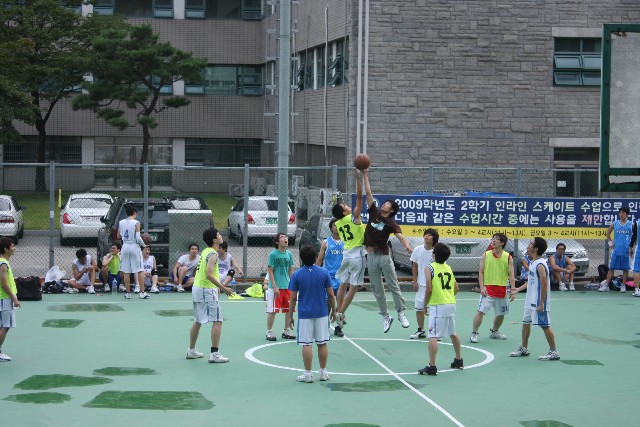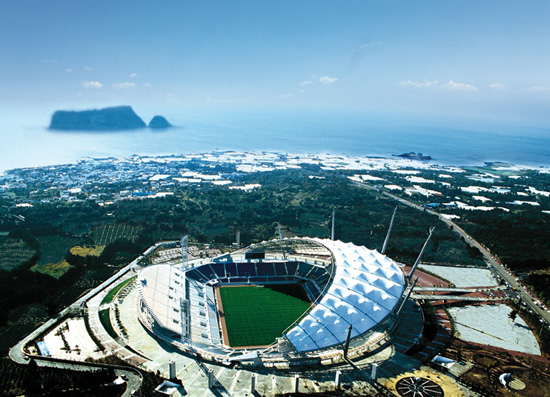1,005 Yonseians' views about the Korean sports industry

THE BIGGEST event of the fall semester, Yon-Ko Athletic Meet, drew down its curtain last month. Many Yonseians showed their school spirit by wearing blue shirts and hats as they cheered for their favorite teams. At the opposite side of the stadium, Korea Univ. students were wearing red, cheering for their teams. It was obvious by the support of the student body that rivalry in the form of sports was a significant part of university life. Students enjoyed watching these exciting sports events such as baseball, basketball, and ice hockey. Not only do sports play an important role in universities but also in societies However, the sports industry in Korea is still in the beginning process compared to other countries. To investigate this situation, The Yonsei Annals took the opportunity to survey Yonseians' preference in sports and their thoughts about other related industries.
The recognition of sports and the sports industry
In the 80's, the Korean economy grew at a fast rate, personal income increased, and the total number of working hours was shortened. As people desired to make use of their leisure time, the recognition of sports spread in the society and people valued the benefits sports could give them. Also, the 3S (Sports, Sex, Screen) policy of the government in those days was deeply associated with the situation, and people became more interested in sports activities. The turning point for the Korean sports industry was when Korea hosted the 1988 Olympics. Prior to this, the industry was restricted only to manufacturing sportswear and sports shoes. From the 80's, the demand for sports equipment and services started increasing rapidly. As the athletes' results from competitions improved by winning lots of games, the sports industry gained more attention. For example, Kim Han-jong (Editor, Dept. of Sports, SBS) said that as Pak Se-ri won the golf tournament in the United States during the financial crisis, many students wanted follow suit and become pro-golfers. These students are called Pak's kids, and they are now famous pro-golfers with great records in pro-golf tournaments. For this reason, the golf industry became highly developed with many golf club and golf wear manufacturers.
 | ||
| Kim Han-jong | ||
| (Editor, Dept. of Sports, SBS) | ||
Since physical education is included in the compulsory education system, Yonseians have had many opportunities to experience a variety of sports during their childhood. Also, Yonsei Univ. opens sports-related courses, and the Department of Sport & Leisure Studies, which provides courses such as sports marketing, contributes to the education on sports. When asked about their interest in sports, 32.34% of Yonseians replied that they are quite strongly interested. Unlike most men, women tend to have less interest in sports, except when losing weight. Even though sports might not be one's favorite hobby or concern, they play a large role in everyone's lives.
Problems in the current sports industry
In spite of the high extent of awareness by people, sports industries in Korea are still at the toddler stage. In Europe, the sports industries already accounts for 3.5% of GDP in the early 21st century. In addition, Japan contributed 3.88% to GDP in 1996 and is constantly increasing. Like these, advanced countries concentrated on improving sports industries by developing related infra stucture or yielding sports related index on the side of the government. Moreover, governments would relieve regulations for enterprises, which are necessary to develop sports to pro-sports. When a sport is played as a profession, it gains more attention. Therefore, if more sports became more professional, they would gain more attention which would help nations achieve more positive recognition globally. Although the industry is constantly increasing now, some serious problems still remain.
First of all, it turned out that 65.89% of respondents answered that there are not enough sports facilities nearby for them to exercise. Though the Ministry of Culture, Sport & Tourism executes a policy of expanding budgets for public sports facilities to let people carry on a healthy lifestyle, most Yonseians do not think it is enough. In spite of the government support, sports are not yet for everyone and there are many people who pay for private fitness centers. Second, laws for domestic sports are insufficient to support the system by only the supporter's organization. The laws fail to protect consumers who buy sports product, to deal with problems between the owner of the team and pro-sports player, and to solve many other problems. Accordingly, corporations who support teams simply obtain the right to advertise their brand, but cannot have extra promotions. Third, there is a lack of domestic sports events. There are some large events such as marathons, but there is no single representative sports event. Inviting foreign sports events is the only way. The domestic sports event is related to sports tourism. If there is an excellent sports event, it can attract foreign tourists and citizens.
Star-izing sports athletes
 | ||
In addition to the structural problems, there are problems dealing with the people who directly work in the industries athletes. Recently, sports stars who achieved great scores in their events have become celebrities. For example, Kim Yu-na, who is a very popular figure skater today, can be seen everywhere. When you turn on the TV, you can see her in a commercial or hear about her on a talk show. Your friend might have makeup kits and clothes that she endorses. There is even a cell phone named after her. She has become more popular than any other entertainer or star. Thanks to her, figure skating is becoming a trendy and promising sport, unlike its unpopular past. However, to athletes who should always focus on their physical strengths and strive toward higher records, this phenomenon is not very positive and unconventional.
According to a survey of Yonseians, 35.83% feel so-so about athletes' entertainment-related activities and 34.51% said that they approved of starization of athletes. However, this is a case in which the majority of people do not understand the real problem. There are some side effects to starizing sports stars' situation. Park Tae-hwan and Choi Min-ho, who were promising stars in their field, have lost competitions this season. Park did not get any medals, and even failed to pass the preliminaries in the 2009 FINA World Championships hosted by Roma. Furthermore, Choi failed to receive a preliminary in the World Championships Judo 2009. There are some explanations for their lack of success this season, but the most notable reason is they were too popular and busy with entertainment businesses to practice for competitions. As a result, a committee took charge of Park to help him get higher records. Both Swimming and Judo in particular need a higher tensioned concentration than other sports. If Park and Choi had personal trainers and managers to keep them focused on their training, perhaps the results would have been different. Though starizing sports players draw people's attention to sports events, excessive popularity without consideration for the athletes' physical training can be dangerous to their careers. This is a result partially caused by inadequate support from the industries. Things may change if corporations that manage sports players provide more support to concentrate on training.
The non-popular sports events
Many problems about sports industries have been revealed, but there is still a problem hidden by the big problems. It is about non-popular sports events. Do you know what lacrosse is? It is a ball game similar to hockey, and it is the oldest sports game in North America. In Korea, there is a women's lacrosse team that participated in the Federation of International Lacrosse (FIL) Women's Lacrosse World Cup 2009, but most people do not even know about the existence of this sport. Likewise, there are lots of unpopular sports events like boating and ski jumping. In such events, it would be recognized by people and governments if there were an outstanding athlete. Without outstanding athletes, the sports events are not noticed by people. In reality, these events depend on the presidents of teams who have the financial power because it is highly difficult and unlikely for most sports events to have athletes with high records. Once figure skating and swimming were unpopular, until Kim Yu-na and Park Tae-hwan won gold medals during the Olympic Games. Popular sports receive various supports and have large-scale fan clubs, whereas unpopular sports remain hidden from public view. The Annals survey revealed that most Yonseians are interested in Korean pro-sports (24.53%). Foreign pro-sports were close behind at 37.86%, while 9.14% of people were interested in E-sports. These events are all for the masses, and the media consists broadcasting programs of the sports events. According to Kim, the media is deeply related to the development of sports industries. If the media broadcasts sports events, people get interested, and corporations can use sports events as indirect advertisement. However, as unpopular sports do not receive high program rating, it is hard for them to be awarded airtime. Fortunately, thanks to the Internet, many people can receive information about a variety of unique sports events; since the number is few, it still remains undeveloped. Of course, it is unfeasible to lead people's unconditional attention. Nevertheless, the current situation needs people's consideration about judging sports stars and events by high scores, their physical features, and their popularity. To develop the sports industry, people should notice that it needs constant care for unpopular sport events.
How to overcome the problems
Based on the above problems, even if the sports get more attention, there are still many problems in the sports industry that keep sports from progressing. The domestic sports industry is still developing, and needs more support from the government to achieve a higher level. The government should keep the following in mind. First, they should enforce laws, and implement systems to support the sports industries. Second, they should provide sports merchandise and information to let people compare things themselves. It can give sports corporations the opportunity to develop. Also, governments would manage efficiently and establish a foundation. Furthermore, the high quality sports events and sports tourism need to be managed by a nation.
For the sports industry, the media is very important. For example, in 1991, SBS programmed events on golf, boxing, and bowling, which were unpopular sports at that time. From then, golf started to gain popularity with the appearance of Pak. Now, many golf industries have been developed, and many golf athletes are winning in major leagues such as the LPGA. Of course, the unpopular events do tend to gain popularity by the sudden rise of stars. However, if media shows more programs of unpopular events shortly regardless of ratings, people become exposed to it and can gain some interests about them.
Two months ago, shocking news about six female hockey players who were once members of the national women's hockey team moved to Azerbaijan was announced. Hockey, especially women's hockey, is unpopular in Korea, and they could not earn much money. Azerbaijan offered more support than Korea, so they decided to go there. This proves the shocking reality of Korea's current sports, industry, different from Germany, where the so-called Golden Plan, a long-term plan for sports has been promoted since 1961. The German Amateur Athletic Association develops lots of programs, and a third of the world's nations became a member of this association. This club recruits promising young stars and establishes sport schools which produce sports leaders. This is a good example of how the sports industry should be improved.
* * *
 | ||
Since figure skating has come into the spotlight, there has been a small group that supported seven unpopular figure skaters on a famous website. It did well at first, but finally ended in a not-so fine way for several reasons. Despite this failure, this group serves as an important model to people. Even if the government should undertake a major plan to develop sports industries, there are many other ways to help athletes considering them more carefully. There should be hundreds of sports, and people should be able to taste many sports; however, people only care about big sports stars and some major pro-sports. People have much interest in sports events and games. However, there is less constant interest, support, and recognition in the preservation of sports. Also, Yonseians can take part in sports by playing them directly. Participating in sports games actually increases your health and your interest in sports.
The definition of Sports Industries
It refers to the industry that includes the following: commodities formed within the sports field; production of related services; and distribution of products. For example, it is applied to athletic matches including a team or a person, produced by economic factors such as stadium, audience, TV press, and game paraphernalia. Moreover, sports industries help people to acquire sports knowledge, economic activities about utilizing sports facilities, and purchase sporting goods. If one nation has a high quality sports industry, it holds high values in the field of sports. It can host many big sporting events like the Olympics, and people can enjoy more interesting sporting events and activities compared to other countries.
 | ||
| This machine is Korea's first soccer ball producing machine. This machine had established the foundation for Korea's soccer ball industry. | ||
Graph 1
Total: 1,005
Gender: Male 607
Female 398
Grade: Freshman 325
Sophomore 210
Junior 233
Senior 234
Undefined 4
Graph 2
How much interests do you usually have in sports?
A lot 22.59%
A little 32.34%
So-so 22.29%
Not much 16.32%
Not at all 6.36%
Graph 3
How much do you know about sport industry?
A lot 6.27%
A little 34.23%
So-so 26.17%
Not much 24.08%
Not at all 4.28%
Don't know 4.97%
Graph 4
How way do you usually participate in sports among the following answers?
Through the media (including sports ToTo) 54.83%
Watching sport games directly 13.33%
Through sport games such as E-Sport 5.57%
Through sport exercising 25.27%
Others 1.00%
Graph 5
Do you think there is enough sports facilities near?
Enough 18.84%
Not enough 65.89%
Don't know 15.28%
No comment 1.69%
Graph 6
How is the quality of sports facilities do you use often?
Very good 5.47%
Good 37.75%
So-so 45.76%
Bad 8.60%
Very bad 2.33%
No commnent 1.69%
Graph 7
What do you think about sports players doing entertainment activities?
Absolutely agree 6.28%
Quite strongly agree 34.51%
So-so 35.83%
Quite strongly disagree 20.14%
Absolutely disagree 3.24%
Graph 8
What is your favorite sports among the following answers? (Double answer possible)
Korean pro-sports 24.53%
Climbing 3.79%
Others 4.83%
Foreign pro-sports 21.81%
Golf 3.97%
Kyuktoogi(K-1, UFC) 4.57%
Swimming 8.66%
Figure Skating 8.79%
Billiard 4.35%
Badminton 5.56%
E-Sports 9.14%
Graph 9
What is the biggest reason do you participate indirectly in sports? (Watching TV)
It is the best proper way to get rid of stress 15.65%
Can get representative satisfaction through games 26.98%
Desire sports players' atheletic abilities 9.63%
Desire sports players' looking or character 2.81%
Can communicate with other people more 7.42%
It is easy to participate indirectly than directly 31.59%
Others 5.82%
No comment 0.80%

